The rise of hookless designs has sparked widespread debate in bicycle rim technology in recent years. Former chairman of the Bicycle Technical Committee, Josh Porter, even bluntly called hookless rims a "scam." However, manufacturers claim that hookless rims offer advantages in terms of lightweighting and aerodynamics. This article analyzes the characteristics of these two types of rims from three aspects: safety, performance, and applicable scenarios, to provide a reference for your choice.

Safety Performance: Hooked Designs May Be More Reliable
The biggest controversy surrounding hookless rims lies in their safety hazards. With the traditional hook structure eliminated, the tire only relies on the tire bead to adhere to the rim surface. Laboratory test data show that some tires may experience a "blowout" (the tire instantly detaches from the rim and leaks air) at a tire pressure of 78-80 psi. The European Tire & Rim Technology Organization has even mandated that hookless rims with an inner width of 23mm must be paired with tires of 28mm or larger; using 25mm tires is considered a very "dangerous" practice.
In contrast, hooked rims, with their raised hook grooves, securely lock the tire bead and support high-pressure riding at over 100psi, while being compatible with mainstream 25-32mm tire sizes, making them the preferred choice for professional road cyclists.

Performance: Advantages and Disadvantages
Aerodynamics
Theoretically, hookless rims help the tire form a more rounded cross-section, reducing airflow separation; the wider rim and tire transition smoothly, reducing wind resistance. However, former industry chairman Porter pointed out that actual wind tunnel data have not proven their advantages. On the contrary, the increased tire width after inflation (e.g., nominal 25mm, measured 28mm) often violates the "105 rule" (rim width must be 105% of tire width for optimal airflow). Hooked rims, by precisely matching rim and tire width (e.g., 28mm tire with 26-28mm rim), more easily meet aerodynamic optimization requirements.

Lightweighting and Production Costs
Hookless rims eliminate the inner hook, resulting in a straighter structure and easier molding; they also require less carbon fiber. Due to the simplified carbon fiber manufacturing process, weight can be reduced by 10%-15%, resulting in a cost advantage.

Impact Resistance: Hookless rims have thicker edges, offering stronger damage resistance in low tire pressure (<40psi) scenarios such as gravel roads and mountain biking. Hooked rims, on the other hand, perform better in deformation resistance during high tire pressure road riding.
Of course, there are differing opinions within the industry regarding these two designs. For example, Zipp and ENVE have implemented a "wheelset + tire" bundled sales strategy to promote hookless rims and improve user riding safety; DT Swiss, however, insists on the hooked design, emphasizing "full compatibility."

Purchase Recommendation: Matching to Needs is Key
Suitable scenarios for hookless rims: Mountain/gravel riding (tire pressure <40psi), recreational road riding, and must be usable within the manufacturer's specifications (e.g., 23mm rims must be paired with 28mm or larger tires, tire pressure ≤73psi).

Recommended scenarios for hooked rims: Racing-level road cycling (especially high-tire-pressure climbing/descent), long-distance endurance races, or users prioritizing tire compatibility. They widely support mainstream 25-32mm tires, offering a greater safety margin.
Friendly reminder: Regardless of the rim type you choose, rim-tire compatibility is crucial. For casual cyclists prioritizing lightweight design and accepting the rim's limitations on tire pressure, hookless rims are an option; conversely, racing enthusiasts and those prioritizing safety are advised to choose traditional hooked rims.




Dejar un comentario
Todos los comentarios se revisan antes de su publicación.
Este sitio está protegido por hCaptcha y se aplican la Política de privacidad de hCaptcha y los Términos del servicio.